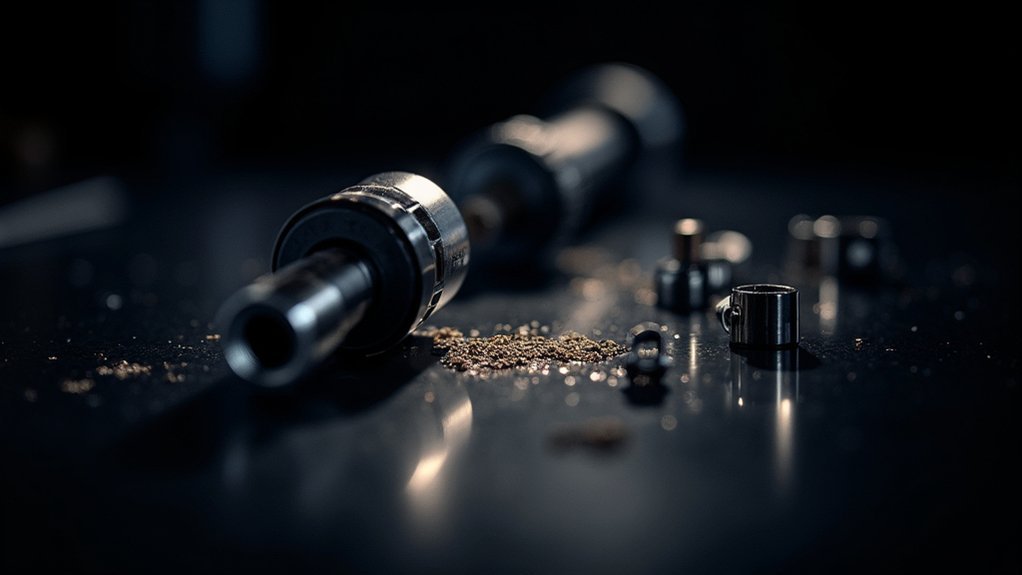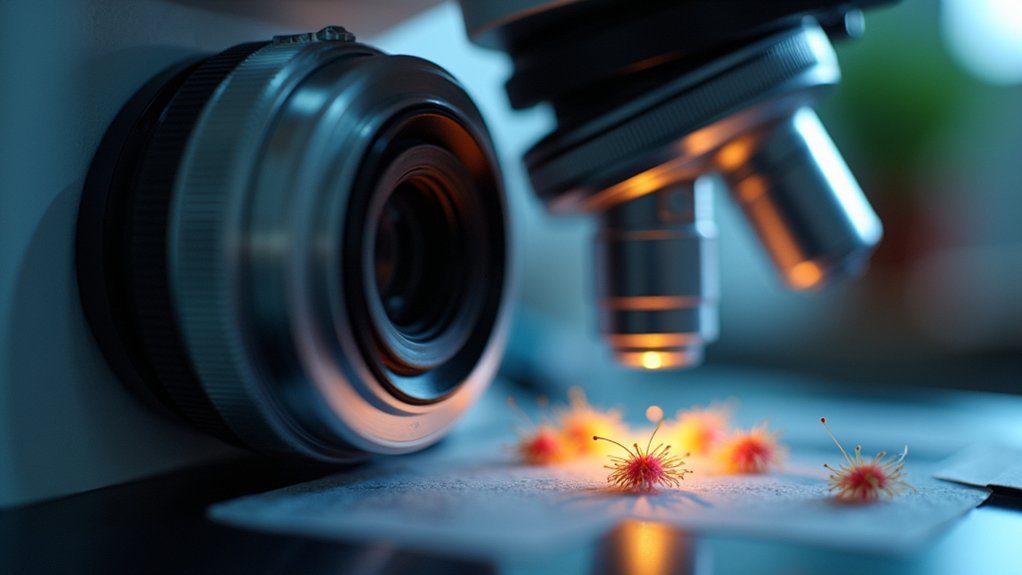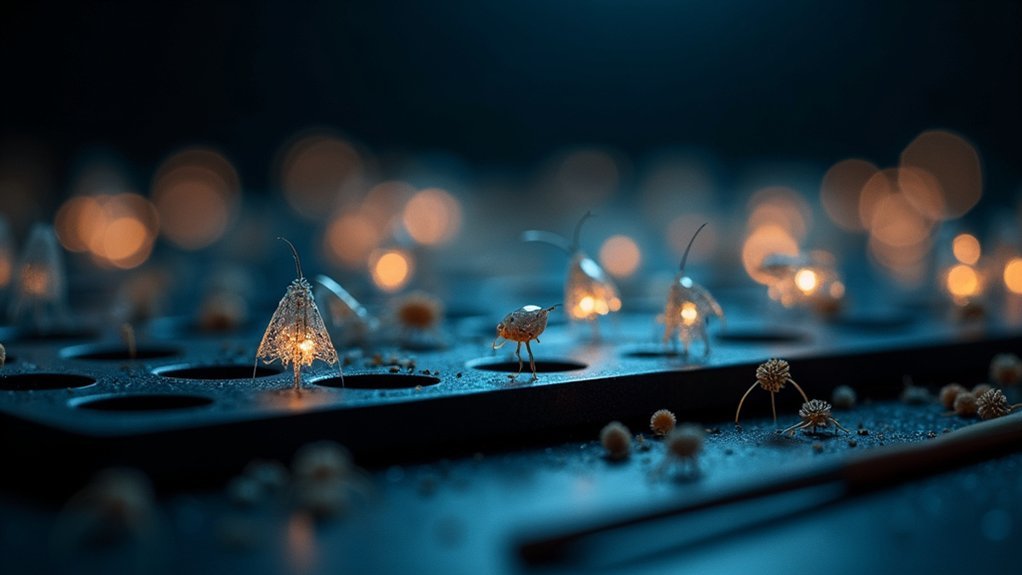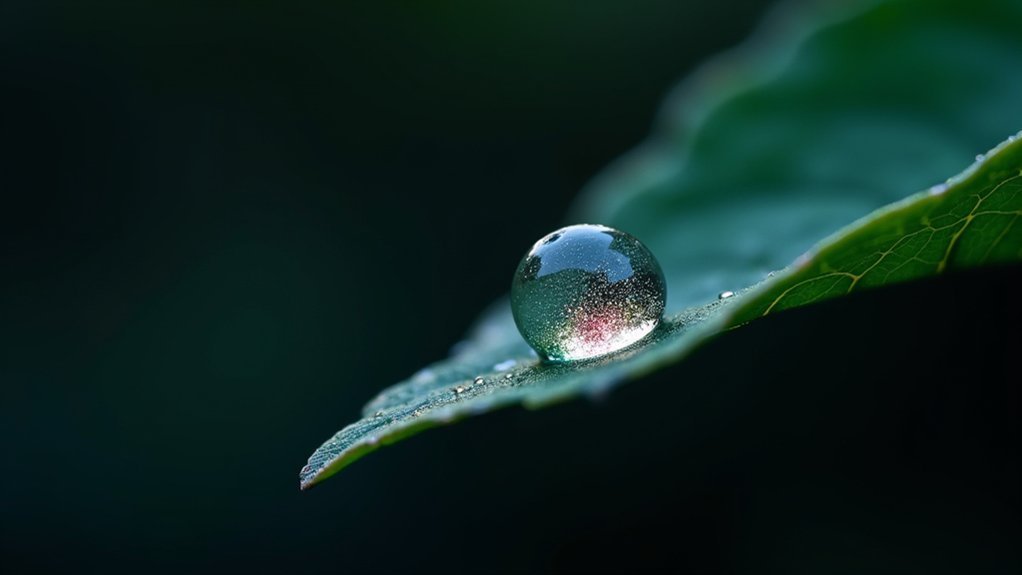For outstanding dark field photography, invest in quality condensers and stops to control oblique lighting angles. Add specialized LED or fiber optic lighting systems for consistent illumination. Secure your setup with proper camera adapters and vibration-reduction platforms to eliminate blur. Consider a focus stacking rail system for capturing microscopic details with impressive depth. Don’t overlook post-processing tools that enhance contrast and reveal hidden textures. The right equipment combination will transform your microscopic subjects into dramatic masterpieces.
Essential Dark Field Condensers and Stops

Every successful dark field photograph begins with the right condenser and stop combination. Your dark field condensers should direct light at oblique angles to your subject, preventing direct reflection while revealing intricate surface details.
When selecting stops for your optical system, consider how they’ll control the light source entering the lens—this directly impacts exposure and contrast in your final images.
You’ll need to experiment with different condenser sizes and stop configurations to achieve the best sharpness. A high-quality condenser paired with adjustable stops helps eliminate unwanted stray light, resulting in crisper, more defined textures.
Make sure your dark field stop fits securely within the optical path for consistent lighting conditions. This careful attention to your condenser-stop setup will dramatically improve your dark field photography results.
Specialized Microscope Lighting Systems
While standard illumination falls short for capturing microscopic detail, specialized lighting systems transform what your camera can reveal in dark field photography. Using LED or halogen sources with oblique angle positioning dramatically enhances your low-light performance when shooting through a microscope.
| Lighting Type | Best For | Key Benefit |
|---|---|---|
| LED Array | Macro lens work | Consistent color temperature |
| Halogen | Transparent specimens | Superior contrast |
| Fiber Optic | Surface textures | Precise light positioning |
You’ll find adjustable intensity controls essential for balancing exposure without overwhelming delicate specimens. Pair your camera with polarizers or diffusers to minimize glare and optimize contrast. Remember that the direction of light matters as much as its strength—position your lighting to create dramatic shadowing that reveals textures invisible under direct illumination.
Camera Adapters for Microscope Integration

Even with the perfect lighting setup, your dark field photography capabilities depend on how effectively your camera connects to the microscope.
Camera adapters create a direct, stable connection between your camera and microscope eyepiece, eliminating the shakiness of handheld shooting that can ruin microscopic photography.
You’ll find various options like the Celestron T-adapter for DSLRs or AmScope’s universal smartphone adapter, each available in different mounts (T2 or C-mount) to match your specific equipment.
These adapters don’t just improve stability—they’re essential for capturing high-resolution images of microscopic subjects with pristine clarity.
For even better results, most adapters accommodate additional accessories such as filters and extension tubes, enhancing your imaging versatility.
The right adapter transforms your camera-microscope combination into a precision dark field photography system.
Focus Stacking Equipment for Enhanced Depth
When working with dark field photography, you’ll need precise focus stacking rail systems like the Cognisys StackShot to capture the minute details that make specimen features stand out.
Software-controlled focus increments allow you to automate the capture process, ensuring consistent steps between each image in your stack. A sturdy tripod partnership with your rail system prevents unwanted camera movement between shots, eliminating alignment issues that could compromise your final composited image.
Rail Systems Maximize Precision
Although capturing stunning dark field photographs requires exceptional attention to detail, rail systems serve as the foundation for achieving superior depth of field through focus stacking.
These precision tools allow you to make minute adjustments in controlled increments, essential when working with macro images where every millimeter matters.
You’ll appreciate the graduated markings on high-quality rails that enable consistent, repeatable movements during your shooting sequence.
With both horizontal and vertical adjustment capabilities, you’ll maintain complete control over your composition while capturing multiple images at varying focal points.
Investing in a premium system from established brands like Manfrotto or Novoflex will dramatically improve your workflow efficiency.
When combined in post-processing, your stacked images will reveal intricate details throughout your subject that would otherwise be impossible to capture in a single frame.
Software Controls Focus Increments
While rail systems provide the physical foundation for focus stacking, specialized software transforms these mechanical movements into photographic magic. Programs like Helicon Focus and Zerene Stacker let you control precise focus increments, seamlessly blending multiple images for exceptional depth of field in dark field photography.
Your focus stacking equipment requires proper calibration to guarantee consistent results. Adjust increments based on your subject’s size and your macro lens’s focal length for ideal sharpness. Most software allows you to fine-tune these settings, preventing gaps in focus that could compromise detail.
When paired with automated rails from manufacturers like Cognisys, this software can automatically capture image sequences at predetermined focus points. You’ll achieve remarkable clarity across the entire subject, even when using wide apertures to maximize light gathering in challenging dark field conditions.
Tripod Stability Prevents Shifts
A rock-solid tripod forms the backbone of successful dark field photography, especially when implementing focus stacking techniques. When shooting long exposures, even the slightest camera shake can ruin your carefully composed shot.
You’ll need a tripod that offers both stability and versatility.
For ideal focus stacking results:
- Choose a tripod with adjustable height features to accommodate various shooting angles while maintaining stability.
- Look for models with quick-release plates to efficiently switch between setups without losing precise alignment.
- Pair your tripod with a macro rail for those incremental adjustments needed to enhance depth of field.
The combination eliminates unwanted shifts between exposures, allowing you to capture multiple sharp images at different focus points.
This equipment synergy creates final compositions with remarkable depth and clarity impossible to achieve handheld.
Vibration Reduction Platforms and Mounts
When shooting dark field photography, you’ll want to contemplate platforms made from carbon fiber or high-density foam that effectively absorb micro-vibrations while maintaining structural integrity.
Vibration-dampening head systems, like fluid heads or electronic stabilizers, offer you precise control when making minute adjustments to capture the perfect grazing light effect.
These specialized mounts work in tandem with your camera’s settings to eliminate movement-related blur, especially during longer exposures when even the slightest tremor can ruin your carefully composed dark field image.
Platform Material Considerations
Since vibrations are the enemy of sharp dark field images, choosing the right platform materials can make or break your photography results. Your mount’s composition directly impacts vibration reduction and overall stability during those vital exposure moments.
Select materials that effectively absorb environmental vibrations while maintaining rigidity.
When selecting your platform materials, prioritize these key factors:
- Density and weight – Heavier platforms naturally resist vibrations better, with materials like solid metal bases offering superior performance.
- Damping properties – Rubber, neoprene, or specialized foam layers absorb vibrations rather than transferring them to your camera.
- Structural integrity – Even the most vibration-resistant materials must maintain their form under your equipment’s weight.
Remember that your adjustable mounts must be compatible with both your camera setup and your chosen platform materials to guarantee seamless integration.
Vibration-Dampening Head Systems
Stability champions know that vibration-dampening head systems represent the vital difference between blurry disappointments and crystal-clear dark field images.
These specialized platforms absorb shocks and minimize camera shake during those essential long exposure shots in low-light conditions.
Unlike standard tripod heads, high-quality vibration-dampening mounts support heavier camera setups while providing superior stability through advanced materials and engineering.
You’ll appreciate the adjustable features that let you fine-tune your camera’s balance and positioning for ideal composition.
When you’re investing in dark field photography equipment, don’t overlook these mounts—they’ll greatly enhance your performance by reducing motion blur during extended exposures.
The improvement in image sharpness is immediately noticeable, making vibration-dampening systems essential for serious photographers working in challenging lighting situations.
Post-Processing Tools for Dark Field Image Enhancement

Although capturing the perfect dark field image requires specialized equipment, the magic truly happens during post-processing.
You’ll need powerful tools like Adobe Photoshop and Lightroom to enhance contrast and bring out surface textures that were invisible to the naked eye. Noise reduction software is essential for eliminating the graininess that often results from the high ISO settings necessary in dark field photography.
To maximize your dark field images:
Step beyond capturing to reveal microscopic worlds through thoughtful post-processing techniques that unlock hidden details.
- Adjust levels and curves to improve dynamic range, revealing subtle details hidden in shadows
- Apply sharpening filters selectively to emphasize edges without introducing artifacts
- Use color correction tools to neutralize any casts from your lighting setup, ensuring accurate subject representation
These post-processing techniques transform good dark field captures into stunning images that showcase intricate textures with remarkable clarity.
Frequently Asked Questions
How Can I Make My Camera Quality Better in the Dark?
You’ll get better camera quality in the dark by using a camera with strong high ISO performance, investing in fast lenses (f/1.4-f/2.8), using a tripod, and adding off-camera lighting when needed.
How Can I Improve My Depth of Field Photography?
To improve your depth of field photography, use wide apertures (f/1.4-f/2.8) for shallow depth, or narrower apertures for deeper focus. Try focus stacking, varying focal lengths, and strategic lighting to enhance dimension in your images.
What Type of Camera Is Best for Night Photography?
For night photography, you’ll want a full-frame camera with excellent high ISO performance like the Sony A7SIII or Canon EOS R. Don’t forget to pair it with fast lenses and a sturdy tripod.
What Are the Best Accessories for Photography?
For photography, you’ll need a good tripod, remote shutter release, versatile lenses, filters, spare batteries, memory cards, and a sturdy camera bag. Don’t forget lens cleaning supplies and a reliable external flash.
In Summary
You’ve now got all the essential add-ons to elevate your dark field photography. From specialized condensers to vibration reduction platforms, each tool plays a vital role in capturing stunning images. Don’t forget to integrate your camera with proper adapters and utilize focus stacking for impressive depth. With these equipment additions and post-processing techniques, you’ll transform ordinary subjects into extraordinary scientific and artistic compositions.





Leave a Reply